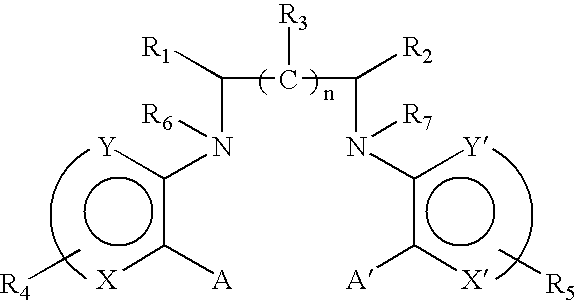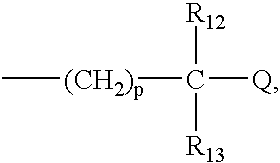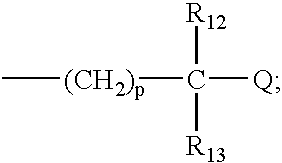Bridged aromatic substituted amine ligands with donor atoms
a technology of aromatic substituted amines and donor atoms, which is applied in the direction of group 3/13 element organic compounds, group 5/15 element organic compounds, drug compositions, etc., can solve the problems of inadequate retention and accretion of effected cells
- Summary
- Abstract
- Description
- Claims
- Application Information
AI Technical Summary
Benefits of technology
Problems solved by technology
Method used
Image
Examples
examples of specific embodiments
of the elements of the above formula include the following.
R.sub.1 and R.sub.2 may be independently selected from hydrogen (H); an oxy group (.dbd.O); --(CH.sub.2).sub.m --Z where m is 0-10 and Z represents a conjugation group or targeting moiety; or --(CH.sub.2).sub.m --W where m is 0-10 and W represents a hydrolyzable group. As used 3 herein, the phrase independently selected means the selection of one substituent may be made without regard for the selection of any other substituent. Alternatively, R.sub.1 and R.sub.2 may be taken together to form a cyclic group, such as an anhydride or a benzene ring. As used herein, a benzene ring may be benzene or benzene with one or more substituents. A substituent may be any electron donating (methyl, methoxy, amino and the like) and / or electron withdrawing (halogens, nitro, carboxy, nitrile and the like) and functional groups (esters, imidates, carbaminates and the like) known in the art. Examples of such substituents include Cl, CH.sub.3, O...
example i
N,N'-bis(2-Diaminophenyl)-1,3-propyldiamino Hexaacetic Acid 5
##STR26##
N,N'-bis (2-Dinitrophenyl)-1,3-oropyldiamine 2:
A stirred suspension of 30.0 g (0.217 mole) of 2-nitroaniline 1, 5.0 mL (0.044 mole) of 1,3-diiodopropane and 1.90 g (0.023 mole) of sodium bicarbonate in 100 mL xylene was heated at 140-145.degree. C. for 36 hours. The reaction mixture was cooled down in an ice bath. The precipitate was collected by filtration. The red solid was washed several times with cold heptane to remove excess unreacted 2-nitroaniline 1 and 2-nitro N-methylaniline. The crude product was purified by flash chromatography on a silica gel column using 20% ethyl acetate in hexane as an elution solvent. After 2-nitro-aniline and 2-nitro N-methylaniline were removed from this solvent system, the desired product was then eluted from the column using 50% ethyl acetate in hexane. The fractions containing the product were combined. Solvent was removed under reduced pressure and dried to yield 10.30 g (15...
example ii
2,3,9,10-Diphenylenyl-1,4,8,11-tetraazacyclo Tetradecane-N,N',N",N'"-tetraacetic Acid 7 and 2,3,9,10-diphenylenyl-1,4,8,11-tetraazacyclo Tetradecane-N,N',N",N'"-tetramethylene Phosphonic Acid 8
##STR27##
2,3,9,10-Diphenplenyl-1,4,8,11-tetraazacyclo Tetradecane 6:
A stirred solution of 10.0 g (0.039 mole) of N,N'-Bis(2-diaminophenyl)-1,3-propane-diamine 3, 2.30 g (0.008 mole) of 1,3-diiodopropane and 6.50 g (0.08 mole) of sodium bicarbonate in 100 mL dry dimethyl sulfoxide is heated at 115.degree. C. for 4 hours under nitrogen atmosphere. The dimethyl sulfoxide solvent is removed under high vacuum and dried. The crude product is extracted three times each time with 100 mL methylene chloride by partitioning with water. The combined methylene chloride layer is washed with brine and water. The organic layer is dried over anhydrous sodium sulfate and filtered. Solvent from the filtrate is removed under reduced pressure to yield crude product. The crude residue is purified by flash chromatog...
PUM
| Property | Measurement | Unit |
|---|---|---|
| Power | aaaaa | aaaaa |
Abstract
Description
Claims
Application Information
 Login to View More
Login to View More - R&D
- Intellectual Property
- Life Sciences
- Materials
- Tech Scout
- Unparalleled Data Quality
- Higher Quality Content
- 60% Fewer Hallucinations
Browse by: Latest US Patents, China's latest patents, Technical Efficacy Thesaurus, Application Domain, Technology Topic, Popular Technical Reports.
© 2025 PatSnap. All rights reserved.Legal|Privacy policy|Modern Slavery Act Transparency Statement|Sitemap|About US| Contact US: help@patsnap.com



